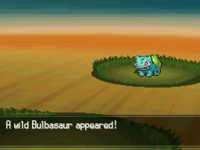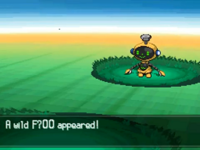Cheating
Cheating refers to the process of playing the Pokémon games through third-party devices to alter the game's data, usually to give the player advantages that would not be available through normal gameplay. Cheating is most frequently used to obtain or duplicate rare Pokémon or items, particularly those which would otherwise require attending a Nintendo event.
Glitches and the games' pseudorandom number generator may also be exploited to circumvent the restrictions of normal gameplay without explicitly cheating.
Overview
In the core series

Devices such as GameShark and Action Replay can be easily used to directly alter the game's data in many ways, such as automatically making Pokémon Shiny, giving them optimal IVs and Natures, or even modifying their moves and statistics to obtain otherwise impossible values. These Pokémon are frequently known as hacked Pokémon. The devices are also frequently used to obtain Pokémon or items which would otherwise be only obtainable through a Nintendo promotional events. For example, cheating may be used to obtain the GS Ball or Old Sea Map (in generations II and III respectively), both of which were only distributed in Japan, or Azure Flute, which was never distributed.

A common example of a cheat is a "Wild Pokémon Modifier" code, allowing the user to encounter and catch any Pokémon of choice in any location, allowing for example, rapid EV training or obtaining of Legendary Pokémon. More complex codes can also set the wild Pokémon's level and Nature. These codes when used properly can have little to no negative effects on the save file, although later generations keep track of the location where a Pokémon was obtained making it possible to identify illegitimate Pokémon obtained through this method. More unconventionally, a wild Pokémon modifier code can be used in Pokémon Black 2 and White 2 to see Pokéstar Studios opponents, although catching them is impossible as the game will attempt to bring up a nonexistent Pokédex entry, causing a game freeze.
Older firmware versions of the Nintendo 3DS were vulnerable to the use of an exploit involving the device's built-in web browser to overwrite the RAM of a suspended game. QR codes were used to link and share these exploits. However, an update in March 2015 patched out the exploit entirely. In addition, more recent firmware versions contain exploits that enable the usage of homebrew software, which can be used to modify the save files of games. There is also external save editing hardware, such as Datel PowerSaves and Cyber Gadget.
On a more sophisticated level, many devices exist that allow players to back up their game's save file. While itself arguably legitimate, some downloadable programs such as Pokésav have been created specifically for use in conjunction with these files, allowing users to freely edit or make their own Pokémon from scratch.
Not all players will use cheating devices to make the game easier. Examples of codes that can be used to make the game harder include using codes to trigger a battle with Professor Oak, or codes that prevent the user's Pokémon from gaining any experience.
In the spin-off games
Trading Card Game series
In Pokémon Trading Card Game and Pokémon Card GB2: Here Comes Team GR!, the duels are automatically saved at certain points, such as when the player draws a card at the start of their turn or places a Pokémon at the Bench. However, not everything is automatically saved, so the player is often able to reset in the middle of a duel and change their recent actions.
Examples involving saving and resetting:
- Peeking at the Prize Cards
- In normal play, the player is unable to know what cards exactly are their Prize Cards. However, if the player picks a Prize Card and then resets the game, they will have the chance to choose the Prize Card again, effectively allowing the player to freely peek at the Prize Cards and choose one to their liking.
- Peeking at the deck
- In normal play, the decks are shuffled and the player is unable to know the order of cards in their deck. However, if the player uses a card that lets them pick a card from the deck (such as Energy Search or Poké Ball), the cards in the deck will be shown in order. Usually, the deck is shuffled after the player picks a card from the deck. The player may want to cheat instead, by memorizing the order of the cards and then resetting the game without picking a card. The game will continue as if the deck was not seen. However, if the player uses a card like Pokémon Trader where a card is placed in the deck in exchange for another, the card added to the deck will appear at the top of the list, so it won't be in the actual deck if the player resets the game.
Criticism
The primary complaint against cheating devices is that it takes no particular ability to enter a cheat code, thus detracting from the point and spirit of the game and making it less enjoyable. While this is a subjective matter, it is the primary cause of cheating offending some players, especially when players can trade illegitimate Pokémon to others in exchange for legitimate Pokémon.
Another argument against cheating is that it often hurts the stability of the game. Improperly used codes can corrupt the game's save file or even delete it altogether.
A common justification for using cheating devices is that they can be used in moderation to obtain otherwise event-exclusive Pokémon. Due to the fact that Nintendo events, the only legitimate way to obtain such Pokémon, are often time-limited and region-exclusive, they can be impossible to obtain for some players solely due to their geographic location, and become altogether impossible after a certain date. It is a matter of opinion whether or not this is a valid excuse for cheating, although when kept for personal use is often criticized less than more drastic cheats.
Preventive measures
Generation III games exclusively contain two specific cheating countermeasures. First, Mew and Deoxys were given special programming that prevents them from ever obeying the player if they were obtained illegitimately, even if the player has the right badges. This can be bypassed if the player uses cheats to get to Faraway Island or Birth Island to catch the Pokémon that way, as the Pokémon itself becomes indistinguishably legitimate, although the event item to arrive at the location is not. This countermeasure does not exist in Generation IV. Second, special programming known as DMA (dynamic memory allocation) causes sensitive memory areas such as Pokémon data to dynamically move around, preventing or making it difficult for cheating devices to target this data. This can be avoided through codes that disable the DMA altogether; such codes are often referred to as "Master Codes".
Related articles

|
This game-related article is part of Project Games, a Bulbapedia project that aims to write comprehensive articles on the Pokémon games. |